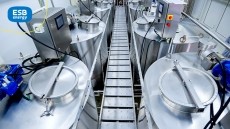Let's click together

Software systems can revolutionise the way business is conducted along the food and drink supply chain, raise customer service levels, while reducing unnecessary waste and improve forecasting and production planning. But they can also be costly white elephants, if not selected and implemented correctly as many early adopters of enterprise resource planning (ERP) systems found to their cost.
However, much has changed since lean guru, Professor Daniel Jones, founder and chairman of the Lean Enterprise Academy, predicted the demise of ERP, claiming systems were far too centralised and inflexible.
While such criticisms of ERP may once have been justified, Julian Mosquera, an ERP expert and director with LCP Consulting, who has worked with food manufacturers as well as the major multiples, argues that they no longer hold true. He is not alone.
"More and more we are finding the ERP systems that we love to hate actually have the functionality they need," says Mosquera. He attributes the blame for past failures on the inflated expectations created by ERP providers. "They were selling a dream that they couldn't get to work with any integrity particularly when you talk about food," he adds.
Flexible forecasts
He cites the field of production planning, where today's systems are more flexible in responding to changes in forecast demand. "Five years ago, but certainly 10, you couldn't talk about an integrated supply chain. The ability to hook up key commodities with your major customers the grocery multiples, or an intermediate manufacturer and link it back to the farm, producer or distribution agency wasn't there."
All that has changed, he claims: "In today's ERP systems I can have my suppliers as part of my key capacity, so I can think of them as an extended enterprise in my manufacturing particularly where they are doing pre-processing for me."
Mosquera notes that decision making in today's food supply chain needs to be far more dynamic and ERP systems provide manufacturers with the flexibility to manage risks they encounter using techniques such as Just-in-Time (JIT) manufacture, late configuration and late assembly of food products.
"We are working with customers where we are literally aggregating multiple builds of material, so we are looking at all of the food ranges where the recipe is different." he adds. "It was almost impossible before to look across multiple customers, multiple recipes, multiple bills of materials, do the aggregation and work out how much I should be investing in that raw material at any moment in time. That can now be virtually done on a laptop."
One area that still needs to witness dramatic improvement, though, is in forecast accuracy, says Mosquera. But systems are now available to help manufacturers achieve better forecasting accuracy and not before time, given the appalling record of many retailers on providing accurate forecasts. As Mosquera points out, because of poor forecasting, retailers sometimes change their demands on suppliers by as much as 200300% without notice.
One company that been able to dramatically improve its forecasting accuracy through the use of Exceedra's demand and sales planning software is Adams Foods. Adams is owned by the Irish Dairy Board and supplies brands, such as Pilgrims Choice cheddar and Kerrygold butter, to the major multiples.
Following a proof of concept with the software, which feeds into its ERP system, Adams' forecasting accuracy has improved from 60% to 75% in just six months, reports the company's supply chain manager Lee McCarthy. But progress has not stopped there.
"We are half way between 75% and 80% at the moment," says McCarthy. "We desperately need to get as close as possible to 90%, but I know it is difficult in the dairy industry."
The installation has forced Adams to change the way it analyses the data it collects. "We started to analyse our forecasts not only the outturn, which is this week or next week, the week after all the way to 13 weeks out," says McCarthy. "We are actually forcing people to look at what the forecast is more accurately 13 weeks out and not just a mad panic two- to three-week process."
The systems have given Adams more confidence that its decisions are based on factual data, says McCarthy. They also help with the analysis of promotional activities, enabling the firm to plan properly for future promotions. Adams can also study to what extent promotions 'cannibalise' sales of other products.
Adams is in phase two of the project, installing full sales planning functionality. This will enable it to look at all promotional plans, while giving all the account managers a web portal-based system, which they didn't have before.
Success in scheduling
"We can see immediately how successful a promotion needs to be for us to make a profit and how successful it would be based on the prices and volumes set," he says. "It gives them the complete year-to-date and year-to-go analysis with full costings and overheads from raw materials to distribution and gives them in a sense of net sales values and the cost of goods sold all the way through their budget process."
The next stage will be to feed this improved forecast data back into production scheduling to enable more efficient operations, such as a sequential production planning and JIT manufacture, says McCarthy. "But that is a long-term goal. That is not something that is going to happen this year, albeit the project will probably start this year."
McCarthy stresses that good preparation is everything. "People forget, you are not just buying a piece of software; you are bolting it on to what you've already got. You've got to clean up your own database and that can sometimes be painful," he says. "Systems are only as good as what you put into them."
Shaun Phillips, global products manager supply chain planning (SCP) for software specialist Infor, agrees that two of the biggest barriers to system implementation are the handling of incompatible data and "change management'" getting new software systems accepted when firms are merged or acquired.
Infor supplies advanced scheduling and planning systems, plus demand planning and sales and operations planning (S&OP) systems. It has just launched integrated business planning within its S&OP module, which Phillips describes as "the next step up for S&OP".
Infor also supplies ERP systems and Phillips agrees that today's systems tend to be smaller, with greater flexibility. "The days of monolithic systems are over," he says.
"When you are implementing a computer system any enterprise system the benefit back to the business really only comes in the last 10% of the functional feet," says Phillips. "Most products can do the 90%, it's those last 10% that you actually start to differentiate yourself. And you say this is the real return on the value."
While Infor works with food and drink firms across the globe, in sectors ranging from dairy to meat processing, it is working on some brewing tank management projects in the UK with Molson Coors at Burton-on-Trent and has supplied production planning and scheduling systems to Samworth Brothers.
One of Infor's particular areas of expertise in the meat sector is in managing "carcass deconstruction" and then shelf-life management as carcasses are transformed into a variety of product cuts. "There are 180 different ways to cut up a lamb and each of those is mutually exclusive," say Phillips. "So the difference is, what is the end product you are producing, how much waste you are producing, and how much is premium product and how much standard."
Increasingly, says Phillips, manufacturers want their systems to handle product portfolio management (PPM) throughout a product's lifecycle particularly as this reduces.
PPM allows them to see clearly what profits are coming from which products and when they are likely to require replacing, he says. "I'm not just looking at my products, which I produce and sell, but what I plan," says Phillips. "I plan for their life, I plan for their obsolescence, I plan for their supersession." The other part of PPM is "opportunity analysis" where demographically to take best advantage of a product's attributes, such as nutritional claims or Fairtrade.
Reducing spreadsheets
At the other end of the spectrum, some firms are at a much earlier stage of their journey down the systems road. When New England Seafood (NES) found itself in a period of fast growth, for example, the finance, sales and IT teams realised that the company's methods of collating business information, reports and analysis were not being met by their existing systems.
In fact most of NES's sales data was being kept in spreadsheets, which often led to delays in running standard reports or data queries.
To resolve this, it installed business intelligence software from Board. This improved its ease and speed of forecasting and reporting, while reducing the reliance on spreadsheets and improving the quality of financial planning and management reporting. It has enabled the firm to combine its spread sheets with accounts information from its ERP system.
"We have now got a system that shines a light on all areas of the business, product profitability, trending of product lines, etc," says NES finance director Charles Noble. "We also now have sales team members doing a lot more analysis themselves, safe in the knowledge that they are dealing with reliable data from one source."
Software systems alone are not the answer to all the industry's supply chain problems. But judiciously used, they are an invaluable tool.

















